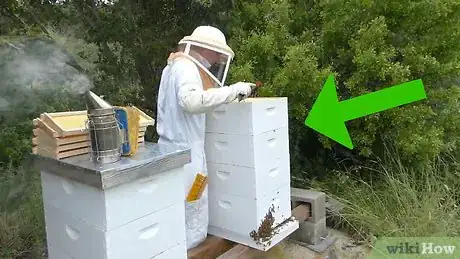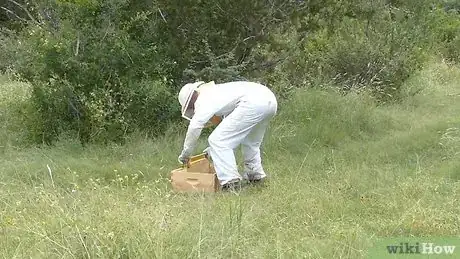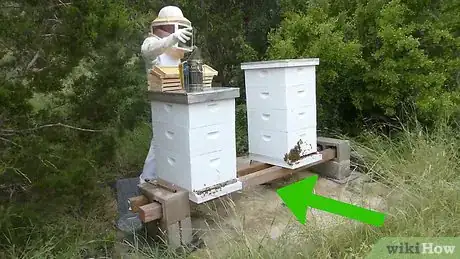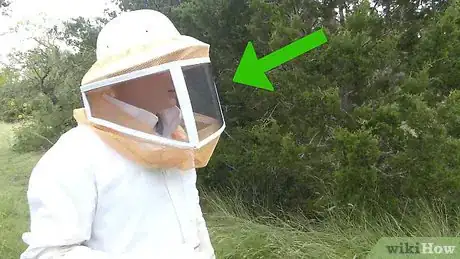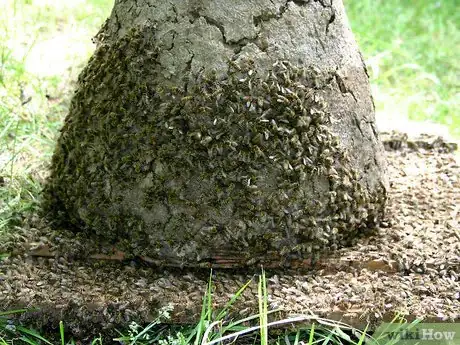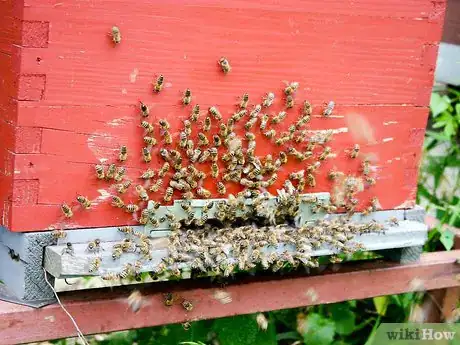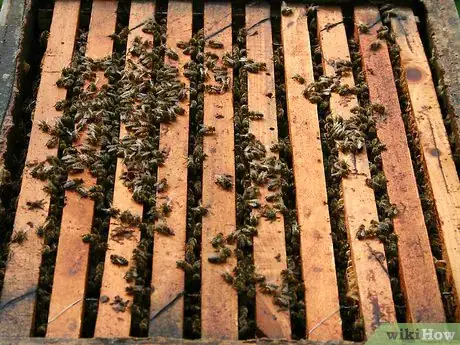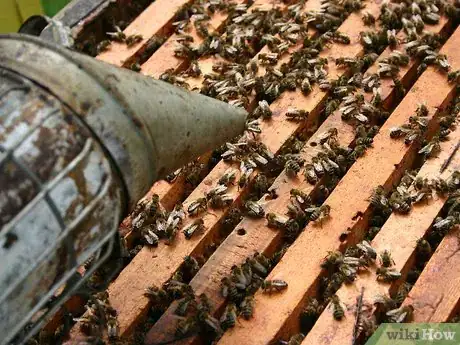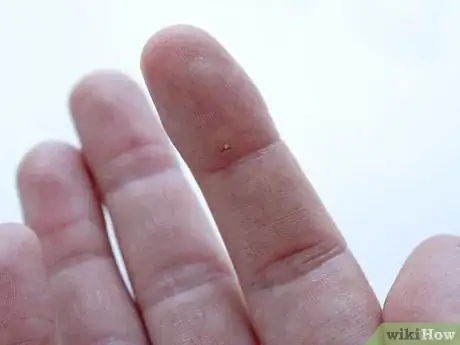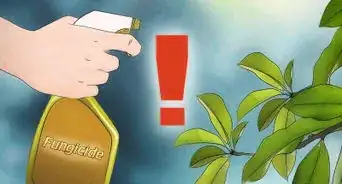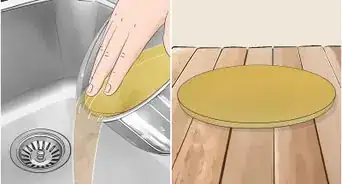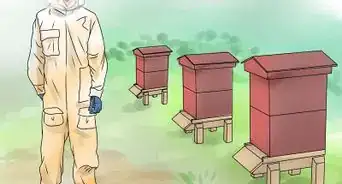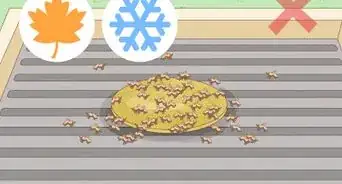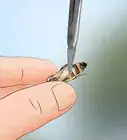This article was co-authored by David Williams. David Williams is a Professional Beekeeper and Bee Removal Specialist with over 28 years of beekeeping experience. He is the Owner of Bzz Bee Removal, a bee removal company based in the San Francisco Bay Area. Bzz Bee Removal locates, captures, and transports bees to local beekeepers to prevent colony collapse disorder.
There are 11 references cited in this article, which can be found at the bottom of the page.
This article has been viewed 59,338 times.
Raising honeybees can be a fun and rewarding pastime that provides you with all the fresh honey you can eat. Maintaining just one hive can even provide you with a side source of income, but many people are intimidated by the prospect of keeping a few thousand bees in their yard. However, honeybees are surprisingly docile, and modern beekeeping methods make the process extremely non-invasive and bee-friendly.
Steps
Setting Up Your Hive
-
1Buy a home for your bees. While honey bees can create hives in all sorts of spaces, most naturally occurring hives don’t respond well to having honey harvested from them. Store-bought hives are designed to allow you to collect the honey with minimal effect on the honey bees.[1]
- Langstroth Hives are the most commonly used in the beekeeping industry because they provide movable frames that won’t interfere with the bees inside when removed.
- Langstroth Hives will not stick together because they were designed to provide passage for the bees in the gaps between the movable pieces.
- Top Bar Hives are designed to be more shallow and sit higher for people who have trouble bending over and may be a good choice for people with back issues.
- Ware Hives are shaped a bit like a house and can be difficult to manage large colonies in, but are great for small hives.[2]
-
2Find a place for the hive. You can keep one colony in most typical sized housing lots. While many people think that means their backyard may be big enough to house a hive of honey bees, there are some other things you will need to consider before placing your hive.[3]
- Find out if there are any zoning requirements for keeping a bee colony in your local area.
- Make sure no one in your family has a bee allergy.
- Let your neighbors know about your hive to see what concerns they may have about their families or health.
Advertisement -
3Make or purchase a hive stand. You will want to keep your honey bee hive off of the ground to make it easier to access and prevent the wood from rotting. A good hive stand will stand about eighteen inches off the ground to protect the hives from wild animals as well.[4]
- A typical hive stand is made of treated 2x4 pieces of lumber laid across stacked cement or concrete blocks.
- Consider putting down mulch, gravel, or stones under your hive stands to limit the mud you will have to deal with.
- Keep the legs of the hive stand in a container of water to prevent ants from getting inside and attacking your bees.[5]
-
4Purchase protective gear. Honey bees are not the most aggressive species of bee, but their sting can still be quite painful. You will need to purchase honey beekeeping protective equipment to prevent them from stinging you as you check on them and harvest the honey.[6]
- A simple hat and veil is often enough protection for most beekeeping activities.
- A light jacket offers additional protection and is often enough for regular beekeeping needs.
- A full suit with gloves is advised for times when the weather is rather windy or the bees seem aggressive.
- You can also make your own beekeeping suit out of ripstop nylon.[7]
-
5Get a smoker. A smoker is a cylinder with bellows attached that houses a slow burning fire. As the fire burns, you squeeze the bellows so smoke comes out the nozzle. This smoke is an excellent way to calm bees down as you work around their hive.[8]
- Burning pine needles, old burlap, wood or purchased smoker fuel are all effective methods of calming bees down.
- Smoke tricks bees into thinking they need to escape a fire and interferes with the pheromones they use to communicate within the hive.
Getting Your Bees
-
1Catch a wild spring swarm. A wild spring swarm is a cluster of bees that have left their hive. You can usually find them temporarily hanging from a tree or bush during the springtime. During that time of year, the swarms will be relatively docile while they prepare to establish a new hive. This is the least expensive, but most dangerous method. [9]
- With beekeeping gear on, you can gather the bees and their queen into an empty hive.
- Place a box below the branch of a tree or bush the bees are currently swarming on. You may be able to shake the branch, causing the majority of the bees to fall in the box but this could anger the bees. Instead, simply cut the branch they are swarming on off the tree and place it in the box for transport.[10]
- This method is not recommended without support from an experienced beekeeper.
-
2Purchase an established hive locally. You may be able to purchase an established hive from a local beekeeper. This can be the easiest way to get started as well as a great way to provide you with a contact that has beekeeping experience.[11]
- These hives usually only cost between $50 and $100.
- Make sure the hive you purchase has been formally inspected by an apiarist or the state department of agriculture. Either test is free to have conducted and can prevent you from having to destroy colonies with communicable diseases.
-
3Order bees by mail. The easiest and most common way to make sure you can establish a hive of healthy honey bees is to order your bees through the mail. The U.S. Postal Service will actually deliver your bees right to your door. A beginner order would usually cost about $30 and entail the following:[12]
- A 3-pound box with 10,000 worker honey bees
- One mated queen that is ready to start laying eggs
- Sugar water to feed the colony during shipment
-
4Place the bees in their new home. It’s surprisingly easy and safe to transfer your bees from the package they came into their new hive that you purchased for them. This process is detailed in instructions that often come with the bees as well.[13]
- Simply place the separately caged queen into the empty hive
- Pour the bees out of the box onto the queen
- The bees do not currently have a hive to defend and will be disoriented so there is very little risk of being stung during this process.
- These colonies will take the first year to build up the number of bees inside and will not yield honey until the second year you have the hive.
Working Your Bees
-
1Start with a friend that has experience. It’s important that you learn the proper way to behave around a beehive from someone with experience. An experienced beekeeper can provide you with wisdom and guidance that may be difficult to find online.
- A seasoned beekeeper’s poise will show you how to remain calm if you get nervous around the hive.
- Having support can make the situation less frightening until you are accustomed to working with bees.
-
2Check on your bees at least every 10 days.[14] You will need to check on the status of your hives more often than you will be harvesting honey. When checking on your hive, simply wearing a hat with a veil is often considered enough protection, but you may also choose to wear a jacket.[15]
- Visit the bees on a sunny day when flowers are in bloom so the majority of the bees will be out and working.
- Wash any clothing bees may have stung previously when visiting, the residual pheromones could incite another attack.
- Use a smoker to fill the hive with smoke and keep the bees docile when opening it to inspect.
-
3Inspect their honey-making progress. Once you have approached the hive, you’ll need to open it and remove some of the interior frames to check on your bees' progress in developing the hive and making honey. Remember to liberally use your smoker throughout this process to pacify the remaining bees.[16]
- Use your hive tool (a small crowbar) to pry up the corner of one of the interior frame walls, then slide it up slowly.
- In different frames you slide out you will find honey or even frames filled with the queen’s larvae.
- Frames that are capped in beeswax are full of honey and ready to be harvested.
-
4Harvest your honey.[17] It’s finally time to reap the reward of beekeeping, a harvest of fresh honey! You may choose to wear your full beekeeping suit to protect yourself during this process, though if you’re careful, it may not be necessary.[18]
- You can purchase a “bee escape” which is a bee trap that allows the bees to enter a container but not leave. As you smoke the hive, most bees will enter the bee escape, allowing you to harvest the honey safely with most bees temporarily displaced.
- Use a pocket knife or small blade to cut the honeycombs out of the frames. The beeswax honey making up the hexagons is also edible.
- A centrifuge specially designed to separate the honey from the honeycombs can also be purchased at specialty stores if you would prefer only the pure honey.
-
5Treat bee stings. It’s inevitable that you will get stung at some point while working with bees. Most experienced beekeepers have been stung many times, but eventually learn to avoid most situations that may result in getting stung. If you are stung, treating a bee sting is fairly easy:
- Remove the stinger as quickly as you can and wash the area with soap and water.
- Apply a cold compress and keep an eye out for signs of an allergic reaction.
- If signs of a moderate allergic reaction arise, take an antihistamine and apply a cortisone cream to the site of the sting.
- If a more severe reaction seems evident, use an epinephrine pen if available and seek medical treatment immediately.[19]
Expert Q&A
-
QuestionWhere should I put my beehive?
 David WilliamsDavid Williams is a Professional Beekeeper and Bee Removal Specialist with over 28 years of beekeeping experience. He is the Owner of Bzz Bee Removal, a bee removal company based in the San Francisco Bay Area. Bzz Bee Removal locates, captures, and transports bees to local beekeepers to prevent colony collapse disorder.
David WilliamsDavid Williams is a Professional Beekeeper and Bee Removal Specialist with over 28 years of beekeeping experience. He is the Owner of Bzz Bee Removal, a bee removal company based in the San Francisco Bay Area. Bzz Bee Removal locates, captures, and transports bees to local beekeepers to prevent colony collapse disorder.
Beekeeper & Bee Removal Specialist Try to find a sunny area since bees need to stay warm to incubate and survive. If you live in a cold climate, you may have to cover your hives in the winter.
Try to find a sunny area since bees need to stay warm to incubate and survive. If you live in a cold climate, you may have to cover your hives in the winter. -
QuestionCan I have a solitary bee?
 Community AnswerThere are many types of solitary bees. A signal honeybee will not last very long.
Community AnswerThere are many types of solitary bees. A signal honeybee will not last very long. -
QuestionI am afraid of bees but I still want to do whatever I can to help the decreasing bee population. Is there anything I can do that doesn't involve making contact with bees?
 Community AnswerTry putting out sugar water, or a mix of water, sugar and pollen. You'll want a syrupy consistency for the latter. You can put it out in small, shallow dishes or hang a jar upside down with holes in the lid. You can also support a local apiary, purchasing product or even simply donating. Note that this is more for small family run organizations; huge corporations don't really need the help.
Community AnswerTry putting out sugar water, or a mix of water, sugar and pollen. You'll want a syrupy consistency for the latter. You can put it out in small, shallow dishes or hang a jar upside down with holes in the lid. You can also support a local apiary, purchasing product or even simply donating. Note that this is more for small family run organizations; huge corporations don't really need the help.
References
- ↑ http://www.motherearthnews.com/homesteading-and-livestock/how-to-raise-honeybees-zmaz85zsie.aspx?PageId=2#ArticleContent
- ↑ https://beebuilt.com/pages/the-best-bee-hive
- ↑ http://www.popularmechanics.com/home/lawn-garden/how-to/g56/diy-backyard-beekeeping-47031701/
- ↑ http://www.popularmechanics.com/home/lawn-garden/how-to/g56/diy-backyard-beekeeping-47031701/
- ↑ David Williams. Beekeeper & Bee Removal Specialist. Expert Interview. 13 February 2020.
- ↑ http://www.popularmechanics.com/home/lawn-garden/how-to/g56/diy-backyard-beekeeping-47031701/
- ↑ David Williams. Beekeeper & Bee Removal Specialist. Expert Interview. 13 February 2020.
- ↑ http://www.popularmechanics.com/home/lawn-garden/how-to/g56/diy-backyard-beekeeping-47031701/
- ↑ http://www.motherearthnews.com/homesteading-and-livestock/how-to-raise-honeybees-zmaz85zsie.aspx?PageId=3
- ↑ https://beebuilt.com/pages/how-to-catch-a-swarm
- ↑ http://www.motherearthnews.com/homesteading-and-livestock/how-to-raise-honeybees-zmaz85zsie.aspx?PageId=3
- ↑ http://www.motherearthnews.com/homesteading-and-livestock/how-to-raise-honeybees-zmaz85zsie.aspx?PageId=3
- ↑ http://www.motherearthnews.com/homesteading-and-livestock/how-to-raise-honeybees-zmaz85zsie.aspx?PageId=4#ArticleContent
- ↑ David Williams. Beekeeper & Bee Removal Specialist. Expert Interview. 13 February 2020.
- ↑ http://www.motherearthnews.com/homesteading-and-livestock/how-to-raise-honeybees-zmaz85zsie.aspx?PageId=4#ArticleContent
- ↑ http://www.motherearthnews.com/homesteading-and-livestock/how-to-raise-honeybees-zmaz85zsie.aspx?PageId=4#ArticleContent
- ↑ David Williams. Beekeeper & Bee Removal Specialist. Expert Interview. 13 February 2020.
- ↑ http://www.motherearthnews.com/homesteading-and-livestock/how-to-raise-honeybees-zmaz85zsie.aspx?PageId=4#ArticleContent
- ↑ http://www.mayoclinic.org/diseases-conditions/bee-stings/basics/treatment/con-20034120
- Videos provided by Blake Kirby
About This Article
If you want to keep bees, figure out where you’d like to put your hive, then check your city’s zoning requirements and ask your neighbors if any of them have bee allergies. Then, purchase a manmade hive, a hive stand to put it on, and protective gear. It’s a good idea to get a hat with a veil, gloves, and a smoker, which is a cylinder with a slow-burning fire inside of it that you can use to calm your bees. Once you have all your supplies, contact a local beekeeper to purchase an established hive. To learn how to harvest honey, keep reading!
